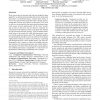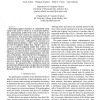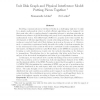120 search results - page 22 / 24 » The worst-case capacity of wireless sensor networks |
SENSYS
2006
ACM
13 years 11 months ago
2006
ACM
Most sensor network research and software design has been guided by an architectural principle that permits multi-node data fusion on small-form-factor, resource-poor nodes, or mo...
NAS
2010
IEEE
13 years 3 months ago
2010
IEEE
The past five years witnessed a rapid development in wireless sensor networks, which have been widely used in military and civilian applications. Due to different requirements in t...
MOBISYS
2005
ACM
14 years 4 months ago
2005
ACM
Abstract-Maintaining optimal consistency in a distributed system requires that nodes be always-on to synchronize information. Unfortunately, mobile devices such as laptops do not h...
DATE
2010
IEEE
13 years 10 months ago
2010
IEEE
—Energy consumption is a critical parameter in wireless healthcare systems which consist of battery operated devices such as sensors and local aggregators. The system battery lif...
IPPS
2009
IEEE
13 years 12 months ago
2009
IEEE
Modeling communications in wireless networks is a challenging task since it asks for a simple mathematical object on which efficient algorithms can be designed, but that must also...



